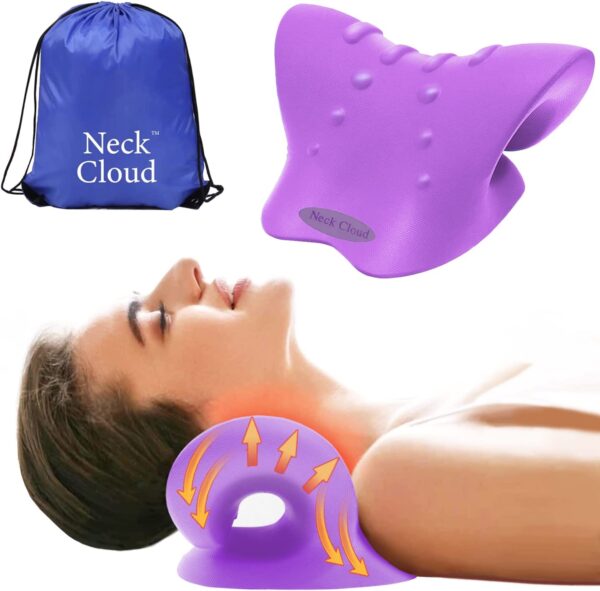Neck Cloud: Ergonomic Design for Optimum Convenience and Pain Decrease
Neck Cloud: Ergonomic Design for Optimum Convenience and Pain Decrease
Blog Article
Neck Pain in the Office: Determining Risk Variables and Applying Ergonomic Solutions
Neck pain in the work environment is a widespread problem that can influence staff member well-being and productivity. By understanding the various danger factors adding to neck pain and implementing ergonomic services, organizations can develop a much more helpful job environment.
Usual Root Causes Of Neck Discomfort
Neck discomfort in the workplace is a widespread issue that can be connected to several usual causes. Additionally, recurring activities such as regular bending, turning, or reaching can also add to neck pain over time.

Ergonomic Danger Variables
Poor comfort designs in the work environment can considerably contribute to neck pain amongst employees. Factors such as incorrect workdesk elevation, inadequate chair support, and awkward positioning of computer system screens can all play a function in the growth of neck discomfort. When employees are forced to rest for extended durations in settings that stress their neck muscles, it can result in tightness, discomfort, and also much more significant bone and joint problems in time.
Furthermore, inadequate ergonomic practices can lead to workers adopting unpleasant positions while functioning, such as craning their necks to see a computer display or getting to uncomfortably for a mouse or keyboard. neck cloud. These recurring movements and unnatural positions can put excessive stress and anxiety on the neck and surrounding muscular tissues, resulting in discomfort and decreased performance

Desk Arrangement Recommendations
To reduce the risk of neck pain and discomfort, there are a number of desk configuration referrals that employees should think about. Make certain that the computer screen is placed at eye degree to stop straining the neck by looking up or down.
It is likewise important to have appropriate lighting to minimize eye pressure, as squinting or leaning forward can result in neck tension. Organize the desk layout to maintain regularly used products within arm's reach, restricting the requirement for recurring turning or reaching activities. By carrying out these desk arrangement suggestions, staff members can develop a more ergonomic work space that supports neck wellness and minimizes the risk of developing job-related neck pain.
Stretching and Exercise Tips
To preserve versatility and lower muscular tissue tension in the office, incorporating stretching and workout regimens can be useful for overall wellness and efficiency. Straightforward desk-friendly stretches can assist reduce neck discomfort and prevent stiffness. Neck rolls, website here shoulder shrugs, and gentle side-to-side neck stretches are reliable in eliminating tension. Additionally, incorporating exercises like chin tucks, shoulder blade squeezes, and top back stretches can help enhance muscles that support good posture.
It is vital to take brief breaks throughout the day to execute these workouts. Setting pointers or using apps that motivate activity can help develop a routine stretching routine. It is essential to pay attention to your body and avoid overstretching, particularly if you are brand-new to these exercises. Uniformity is key, so aim to include stretching and exercise right into your daily work regimen. By focusing on these activities, you can enhance your physical well-being, lower the risk of neck pain, and boost your general efficiency in the office.
Value of Normal Breaks
In a busy work environment where demands can add to physical pressures like neck pain, developing a regimen that highlights the relevance of regular breaks is critical. By incorporating brief breaks into the work routine, workers can reduce the risk of establishing neck discomfort and enhance total comfort and efficiency.
These breaks can likewise serve as an opportunity for employees to exercise leisure strategies or mild neck stretches, better promoting musculoskeletal wellness. Applying a culture that values address and prioritizes regular breaks can have a significant influence on lowering neck anchor pain and enhancing overall well-being in the work environment.
Verdict
Finally, dealing with ergonomic risk variables and implementing proper workstation configurations are important in minimizing neck discomfort in the work environment. By promoting good posture, offering sufficient assistance, and encouraging normal breaks and stretches, organizations can create a much healthier and extra efficient job setting for workers. Prioritizing employee well-being via ergonomic services is key to stopping pain and enhancing general work environment satisfaction.
Neck pain in the work environment is a common issue that can influence worker health and performance. By recognizing and attending to these common reasons of neck discomfort in the work environment, employers can take aggressive actions to develop an extra comfortable and ergonomic job environment for their staff members.
Poor functional designs in the workplace can significantly add to neck pain amongst employees. By implementing these desk setup referrals, workers can produce a much more ergonomic work space that supports neck health and wellness and lowers the risk of developing occupational neck discomfort.
Neck rolls, shoulder shrugs, and gentle side-to-side neck stretches are effective in easing tension.
Report this page